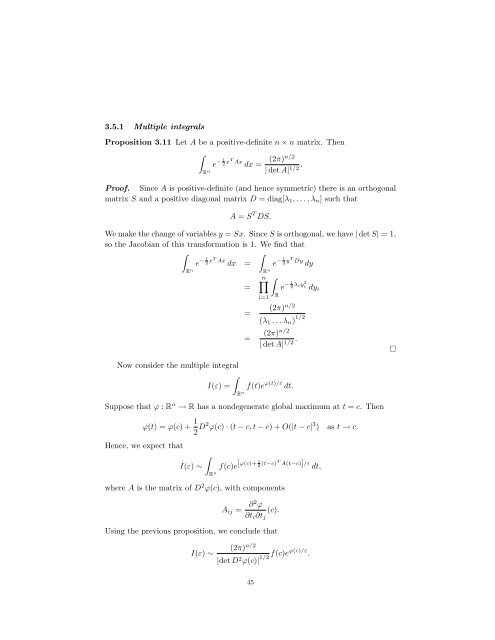Asymptotic Analysis and Singular Perturbation Theory
Asymptotic Analysis and Singular Perturbation Theory
Asymptotic Analysis and Singular Perturbation Theory
You also want an ePaper? Increase the reach of your titles
YUMPU automatically turns print PDFs into web optimized ePapers that Google loves.
3.5.1 Multiple integrals<br />
Proposition 3.11 Let A be a positive-definite n × n matrix. Then<br />
<br />
1 −<br />
e 2 xT Ax (2π)<br />
dx = n/2<br />
.<br />
| det A| 1/2<br />
R n<br />
Proof. Since A is positive-definite (<strong>and</strong> hence symmetric) there is an orthogonal<br />
matrix S <strong>and</strong> a positive diagonal matrix D = diag[λ1, . . . , λn] such that<br />
A = S T DS.<br />
We make the change of variables y = Sx. Since S is orthogonal, we have | det S| = 1,<br />
so the Jacobian of this transformation is 1. We find that<br />
<br />
<br />
R n<br />
1 −<br />
e 2 xT Ax<br />
dx =<br />
Now consider the multiple integral<br />
<br />
I(ε) =<br />
R n<br />
=<br />
=<br />
=<br />
R n<br />
n<br />
<br />
i=1<br />
1 −<br />
e 2 yT Dy<br />
dy<br />
R<br />
1 −<br />
e 2 λiy2 i dyi<br />
(2π) n/2<br />
(λ1 . . . λn) 1/2<br />
(2π) n/2<br />
.<br />
| det A| 1/2<br />
f(t)e ϕ(t)/ε dt.<br />
Suppose that ϕ : R n → R has a nondegenerate global maximum at t = c. Then<br />
ϕ(t) = ϕ(c) + 1<br />
2 D2 ϕ(c) · (t − c, t − c) + O(|t − c| 3 ) as t → c.<br />
Hence, we expect that<br />
<br />
I(ε) ∼<br />
R n<br />
1<br />
[ϕ(c)+ f(c)e 2 (t−c)T A(t−c)]/ε<br />
dt,<br />
where A is the matrix of D 2 ϕ(c), with components<br />
Aij = ∂2ϕ (c).<br />
∂ti∂tj<br />
Using the previous proposition, we conclude that<br />
I(ε) ∼<br />
(2π) n/2<br />
|det D 2 ϕ(c)| 1/2 f(c)eϕ(c)/ε .<br />
45
















